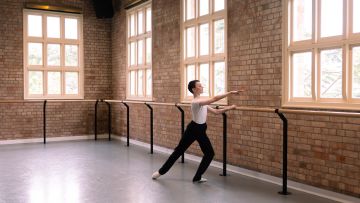Ballet and battlefields: a boys in ballet feature

War veterans, rugby players, SAS soldiers, and boxers: dig past the stereotype of boys in ballet and you’ll find links to some of the most masculine-perceived fields across history.
As we wrap up Ballet for Veterans - a new pilot program with the Australian Defence Force using ballet for trauma therapy, we spoke with Ballet Master and RAD (Royal Academy of Dance) Australian Male Dance Ambassador Matthew Lawrence about how to change the perception of ballet for boys.
Hi Matthew, you’ve done quite a bit of research into the history of men in ballet, and it’s more surprising than people would think. Can you give us a quick breakdown?
According to dance historian Jennifer Homans, ballet’s very early origins were as an adjunct military art form: even today you can see the similarities in positioning – attention, at ease, first position, the lines, the patterns, the precision. Ballet was also done with equestrian and fencing and in the 1700s during the King Louis XIV days, it evolved to performance art at the courts, royal festivals and ceremonies. Throughout the French Revolution it became about aristocracy and that’s where it really evolved into a more popular kind of entertainment. Then during the Romantic period in the 19th century it changed quite a bit. The role of the man was lessened to one of support for the women, and it focused on the ballerina, almost becoming more of a gentlemen’s viewing art form. Previously to that it was a lot more male centric, and ladies didn’t dance much at all.
You have been teaching Queensland Ballet’s pilot program, Ballet for Veterans – a PhD work by Lieutenant Colonel Rick Maher that will be submitted to the Australian Defence Force (ADF). What else can you tell us about this exciting program?
I’ve been working with Rick Maher from the ADF on developing a curriculum, bringing that old somatic form of movement that the military has always used, that’s part of their DNA, and uniting it with ballet. It brings back that sense of camaraderie but in a very different movement space. It’s still that same military precision, still looking at lines, coordination, and physicality, but evolving it and bringing it back full circle. After this 12-week pilot program, we’ll do an eight-week, 12-class program and send the results from that, along with the surveys and research, to the ADF.
It sounds fascinating. Is this the first time ballet has been explored with war veterans?
It’s an exciting space, and it’s the first time it has really been systematically developed. The U.S. has a program called EXIT12 Dance Company which also works with veterans in a dance space, but it’s more a performance dance space whereas ours is a syllabus, quantifiable space. Rick Maher is a former military officer who took up ballet classes and approached me with the idea, because he enjoyed it from that perspective. He did a lot of research into the relationship between ballet and the military, and we have developed this curriculum from there.
It really changes the way you think about ballet…
It flips it on its head. But there are lots of great stories about other fields and sports and athletes using ballet techniques in their pursuits. From a mechanical perspective, ballet is a dance art form that is sports-based. We’re elite athletes, but from an athletic pursuit that has evolved over hundreds of years. What shoved sports away from it for a number of generations was obviously the stereotype, however in ballet’s DNA is a systematic approach to developing muscle strength and technique for lifting and moving efficiently in a space. And you can apply those core concepts to anything.
So is breaking down the boys in ballet stigma simply about re-education?
I think it’s about making people aware of those kinds of links and then, in my experience, it began with my dad, because I listened to my dad. Whether it’s mums, dads, carers or other role models, we need to target the first link in the chain. Part of the Ballet for Veterans project is also breaking down that stereotype, saying well if this guy is doing it, and he has been out on the battlefield, he has seen the best and the worst of life, I don’t think you want to insult that guy… (laughs). For me, ballet should be represented as an art form without stigma – it’s an art form for everyone.
So these sorts of programs are really powerful in terms of that. And the more we can create surprising environments and projects where people never thought ballet could encroach on, like Dance for Parkinson’s, Dance for Veterans, Dance for Brain Injury, it breaks it down because it’s like – wow, this is an interesting space. People can see it as relevant, as beneficial, and in a way they’ve never thought about it before.
by Cassandra Houghton
Photo: Jiří Kylián's Soldier's Mass, 2019 season, by Darren Thomas
Read more in-depth stories in Queensland Ballet's Pas Magazine



